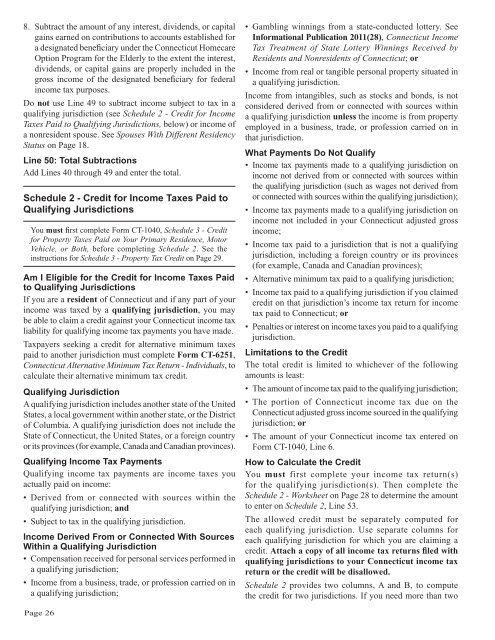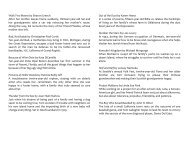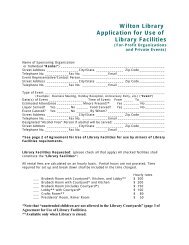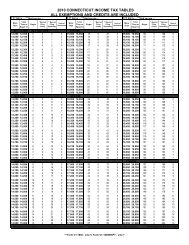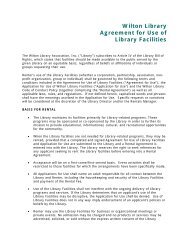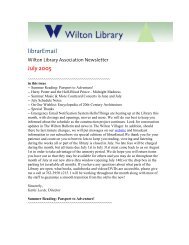CT-1040 Instructions, 2011 Connecticut Resident Income Tax - CT.gov
CT-1040 Instructions, 2011 Connecticut Resident Income Tax - CT.gov
CT-1040 Instructions, 2011 Connecticut Resident Income Tax - CT.gov
You also want an ePaper? Increase the reach of your titles
YUMPU automatically turns print PDFs into web optimized ePapers that Google loves.
8. Subtract the amount of any interest, dividends, or capital<br />
gains earned on contributions to accounts established for<br />
a designated beneficiary under the <strong>Connecticut</strong> Homecare<br />
Option Program for the Elderly to the extent the interest,<br />
dividends, or capital gains are properly included in the<br />
gross income of the designated beneficiary for federal<br />
income tax purposes.<br />
Do not use Line 49 to subtract income subject to tax in a<br />
qualifying jurisdiction (see Schedule 2 - Credit for <strong>Income</strong><br />
<strong>Tax</strong>es Paid to Qualifying Jurisdictions, below) or income of<br />
a nonresident spouse. See Spouses With Different Residency<br />
Status on Page 18.<br />
Line 50: Total Subtractions<br />
Add Lines 40 through 49 and enter the total.<br />
Schedule 2 - Credit for <strong>Income</strong> <strong>Tax</strong>es Paid to<br />
Qualifying Jurisdictions<br />
You must first complete Form <strong>CT</strong>-<strong>1040</strong>, Schedule 3 - Credit<br />
for Property <strong>Tax</strong>es Paid on Your Primary Residence, Motor<br />
Vehicle, or Both, before completing Schedule 2. See the<br />
instructions for Schedule 3 - Property <strong>Tax</strong> Credit on Page 29.<br />
Am I Eligible for the Credit for <strong>Income</strong> <strong>Tax</strong>es Paid<br />
to Qualifying Jurisdictions<br />
If you are a resident of <strong>Connecticut</strong> and if any part of your<br />
income was taxed by a qualifying jurisdiction, you may<br />
be able to claim a credit against your <strong>Connecticut</strong> income tax<br />
liability for qualifying income tax payments you have made.<br />
<strong>Tax</strong>payers seeking a credit for alternative minimum taxes<br />
paid to another jurisdiction must complete Form <strong>CT</strong>-6251,<br />
<strong>Connecticut</strong> Alternative Minimum <strong>Tax</strong> Return - Individuals, to<br />
calculate their alternative minimum tax credit.<br />
Qualifying Jurisdiction<br />
A qualifying jurisdiction includes another state of the United<br />
States, a local <strong>gov</strong>ernment within another state, or the District<br />
of Columbia. A qualifying jurisdiction does not include the<br />
State of <strong>Connecticut</strong>, the United States, or a foreign country<br />
or its provinces (for example, Canada and Canadian provinces).<br />
Qualifying <strong>Income</strong> <strong>Tax</strong> Payments<br />
Qualifying income tax payments are income taxes you<br />
actually paid on income:<br />
• Derived from or connected with sources within the<br />
qualifying jurisdiction; and<br />
• Subject to tax in the qualifying jurisdiction.<br />
<strong>Income</strong> Derived From or Connected With Sources<br />
Within a Qualifying Jurisdiction<br />
• Compensation received for personal services performed in<br />
a qualifying jurisdiction;<br />
• <strong>Income</strong> from a business, trade, or profession carried on in<br />
a qualifying jurisdiction;<br />
• Gambling winnings from a state-conducted lottery. See<br />
Informational Publication <strong>2011</strong>(28), <strong>Connecticut</strong> <strong>Income</strong><br />
<strong>Tax</strong> Treatment of State Lottery Winnings Received by<br />
<strong>Resident</strong>s and Nonresidents of <strong>Connecticut</strong>; or<br />
• <strong>Income</strong> from real or tangible personal property situated in<br />
a qualifying jurisdiction.<br />
<strong>Income</strong> from intangibles, such as stocks and bonds, is not<br />
considered derived from or connected with sources within<br />
a qualifying jurisdiction unless the income is from property<br />
employed in a business, trade, or profession carried on in<br />
that jurisdiction.<br />
What Payments Do Not Qualify<br />
• <strong>Income</strong> tax payments made to a qualifying jurisdiction on<br />
income not derived from or connected with sources within<br />
the qualifying jurisdiction (such as wages not derived from<br />
or connected with sources within the qualifying jurisdiction);<br />
• <strong>Income</strong> tax payments made to a qualifying jurisdiction on<br />
income not included in your <strong>Connecticut</strong> adjusted gross<br />
income;<br />
• <strong>Income</strong> tax paid to a jurisdiction that is not a qualifying<br />
jurisdiction, including a foreign country or its provinces<br />
(for example, Canada and Canadian provinces);<br />
• Alternative minimum tax paid to a qualifying jurisdiction;<br />
• <strong>Income</strong> tax paid to a qualifying jurisdiction if you claimed<br />
credit on that jurisdiction’s income tax return for income<br />
tax paid to <strong>Connecticut</strong>; or<br />
• Penalties or interest on income taxes you paid to a qualifying<br />
jurisdiction.<br />
Limitations to the Credit<br />
The total credit is limited to whichever of the following<br />
amounts is least:<br />
• The amount of income tax paid to the qualifying jurisdiction;<br />
• The portion of <strong>Connecticut</strong> income tax due on the<br />
<strong>Connecticut</strong> adjusted gross income sourced in the qualifying<br />
jurisdiction; or<br />
• The amount of your <strong>Connecticut</strong> income tax entered on<br />
Form <strong>CT</strong>-<strong>1040</strong>, Line 6.<br />
How to Calculate the Credit<br />
You must first complete your income tax return(s)<br />
for the qualifying jurisdiction(s). Then complete the<br />
Schedule 2 - Worksheet on Page 28 to determine the amount<br />
to enter on Schedule 2, Line 53.<br />
The allowed credit must be separately computed for<br />
each qualifying jurisdiction. Use separate columns for<br />
each qualifying jurisdiction for which you are claiming a<br />
credit. Attach a copy of all income tax returns filed with<br />
qualifying jurisdictions to your <strong>Connecticut</strong> income tax<br />
return or the credit will be disallowed.<br />
Schedule 2 provides two columns, A and B, to compute<br />
the credit for two jurisdictions. If you need more than two<br />
Page 26


